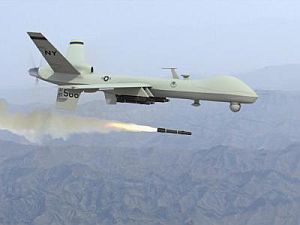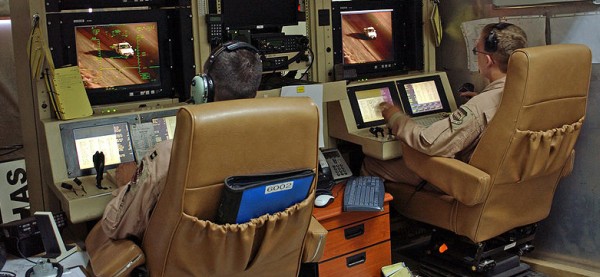
Newsweek reports:
For weeks now, as missiles from American drones have snuffed out their leaders and terrorized their recruits in the remote mountains of Pakistan’s North Waziristan area, Al Qaeda fighters have kept their spirits up by telling each other they were about to have their revenge. “It’s like they’ve just been waiting for news, as if they were all excited about something big about to happen in the West,” says an Afghan Taliban intelligence officer known to Newsweek who operates as a liaison between his organization and Al Qaeda. For security reasons he would not allow his name to be published. The source said one senior Qaeda activist told him that Europeans and Americans think “our minds and bodies are in the mountains of the [Pakistan] tribal areas, but soon we will carry out a visible offensive with long-term consequences in their own Western homes and cities.”
Reports out of Britain overnight suggest that more than bravado may be at work here: according to anonymous sources cited by Sky News foreign-affairs editor Tim Marshall, intelligence agencies have uncovered terrorist plans to launch simultaneous commando-style attacks in Germany, France, and Britain that would be reminiscent of the slaughter in Mumbai almost two years ago. Such attacks have been a major concern of Western police forces because they require no special weaponry — just guns, training, and a will to die fighting.
Marshall says that the dramatic increase in drone attacks over the last few weeks is intended to disrupt the plot against European targets. One drone strike reportedly killed the head of Qaeda operations in Afghanistan and Pakistan, known as Shaikh Fateh, just last Saturday. Marshall quoted his sources telling him the Qaeda plot was in an “advanced but not imminent stage” and that intelligence agencies had been tracking the operatives “for some time.” The implication is that the onslaught of drone attacks, especially in the last month, has succeeded in thwarting the plot.
If the plot is not at an imminent stage, one wonders why the Eiffel Tower has been evacuated twice this month. But whether imminent or advanced, the logic behind the response to the threat — escalating drone attacks in Pakistan — ought to hinge on where these Qaeda commando teams are now located.
ABC News reports on intelligence gathered from a suspected German terrorist who is now being held at Bagram airbase near Kabul. “The captured German reportedly said several teams of attackers, all with European passports, had been trained and dispatched from training camps in Waziristan and Pakistan.”
If they’ve already been dispatched, what’s the point of launching drone attacks on these training camps now? Is this about thwarting terrorism or about adopting a combative posture? A way of saying: we’re not doing nothing; we’re doing something. It might not work, but we sure as hell won’t take this lying down.
Or maybe it’s what might be called preemptive retribution — a foretaste of what will happen after a major al Qaeda attack.
As Bob Woodward’s new book reveals, “if a Pakistani-based terrorist ever managed to strike inside the United States, the CIA had a ‘retribution plan’ to strike at least 150 camps in Pakistan.”
Retribution is another name for revenge and the inchoate rationale that drives revenge is the desire to eliminate the enemy.
“Who did we get today,” White House chief of staff Rahm Emanuel would ask, as though a finite list of drone targets could be whittled down to zero — even while the director of the CIA warned him that this could go on forever.
Almost a decade after 9/11, the mere fact that a retribution plan with 150 targets could be drawn up, is a clear indication of a failed strategy.
Of course this elimination strategy is doomed because it confuses human bodies with the ideas and sentiments that animate them. The bodies can be destroyed but the spirit moves on to animate another combatant. Indeed, the drone can best be seen as the worst kind of force multiplier — one that invigorates the enemy and boosts support among the local population.
As Stephen Farrell astutely noted after being able to observe the Taliban while he was held captive last year, as much as anything else the significance of the drone is not its destructive power but what it signals: the absence of foreign soldiers.
The US commands the sky over Waziristan because it dare not occupy the land.
As for whether a terrorist attack in France is actually imminent, the raised level of alertness prompted by official warnings has been matched by a raised level of suspicion.
Opposition figures and pundits alike have loudly speculated that the troubling pronouncements are actually a ruse to turn attention away from scandals that have implicated government members and from growing protest against pension reform. French media have even suggested that President Nicolas Sarkozy, whose approval ratings are in the doldrums, has borrowed the tactic of the well-timed terrorism scare from the playbook of former U.S. President George W. Bush.
“The French people aren’t duped,” says Socialist Party official and former presidential candidate Ségolène Royal in a remark typical of the skeptics. “The fight against terrorism is a serious and discreet effort, incompatible with sudden alert announcements — made, by chance, as protests surge. There’s an element of stagecraft in this that’s out of line and even dangerous.”
The lesson of the last decade should be that what governments do to prevent terrorism matter less than what they do afterwards.
Thus far, local horror has been a reliable catalyst for global folly.


 Bob Woodward’s new book,
Bob Woodward’s new book, 